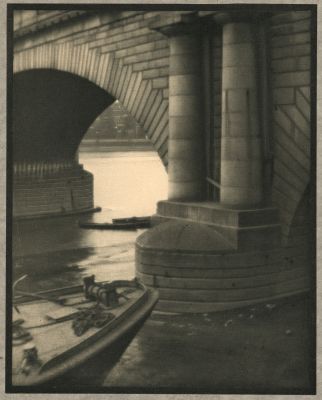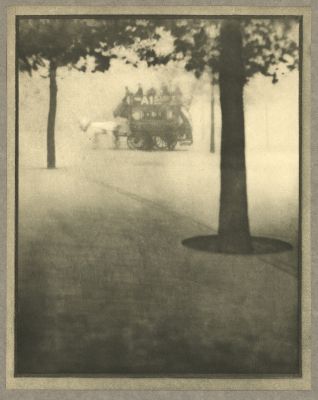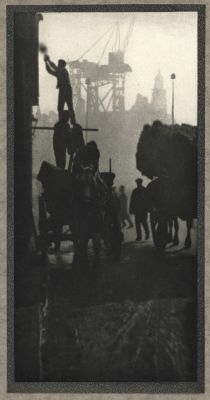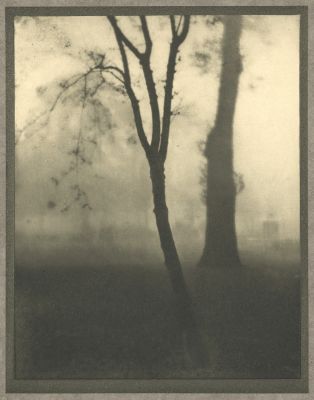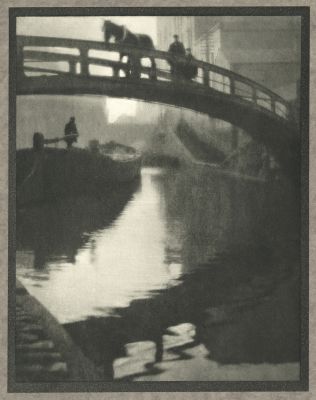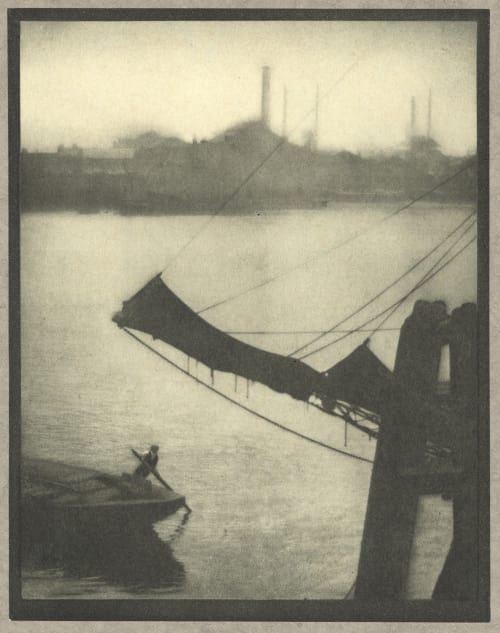
Title
WappingArtist
Coburn, Alvin Langdon (American, 1882-1966)Key FigurePublication
LondonDate
1910Process
PhotogravureAtelier
Alvin Langdon CoburnImage Size
22.7 x 17 cm
This study of the Thames at Wapping shows Coburn’s attention to the motifs and structures of Japanese prints. In 1903, he studied with the American artist and educator Arthur Wesley Dow, who taught Japanese-inspired compositional elements he called ‘notan’. Coburn later collected prints by Hokusai and Hiroshige as well as contemporary Japanese works.
According to the British writer, George Bernard Shaw: "This collection of photographs of London has been in preparation by Mr. Coburn for the past five years, but technically they represent the latest development of his art. Recognizing… that in photogravure he has now, as the impressions in this volume show, produce prints comparable to his finest achievements in gum-platinotype, but reproduce them with a certainty at a cost which makes such a publication as the present possible."
London is Coburn’s first, groundbreaking photo book. The 20 elegant hand-pulled photogravure plates are tipped onto rich gray paper and were prepared by Coburn himself. Poised at a crucial turning point in the history of photography, representing the transition from pictorialism to modernism, this work illuminates the concern of the more advanced pictorialist with ‘modern’ subjects, namely the 20th-century city—a shift in attitude that triggered the final push towards photographic modernism. [1].
Boston-born Coburn based himself in London from around 1906, learning how to make photogravures at the London County Council School of Photo-engraving, and establishing a studio with two copperplate printing presses at the home he shared with his mother in Hammersmith. "In the period 1909-14 he etched and steel-faced eighty-three plates, and oversaw the printing of some 40,000 hand-pulled gravures." His first two publications London (1909) and New York (1910), were intended as the start of a series, exploring "the adventures of cities" each containing twenty luscious hand-pulled photogravures. A key member of Alfred Stieglitz’ Photo-Secession and a friend of many Cubists, "Coburn had one foot in the 19th century and one foot in the 20th century. [2]
Reproduced / Exhibited
Nordström, Alison D, Thomas Padon, and J L. Ackerman. Truthbeauty: Pictorialism and the Photograph As Art, 1845-1945. Vancouver, B.C: Douglas & McIntyre, 2008. Print. p. 32
Foster, Sheila J, Manfred Heiting, and Rachel Stuhlman. Imagining Paradise: The Richard and Ronay Menschel Library at George Eastman House, Rochester. Göttingen: Steidl, 2007 p. 224
Weaver, Mike. Alvin Langdon Coburn, Symbolist Photographer, 1882-1966: Beyond the Craft. New York: Aperture, 1986. p. 19
Harker, Margaret F. The Linked Ring: The Secession Movement in Photography in Britain, 1892-1910. London: Heinemann, 1979. 1.6
Marien, Mary W. Photography: A Cultural History. Englewood Cliffs, NJ: SunSoft Press, 2002. fig. 4.40.
Taylor, John. Pictorial Photography in Britain, 1900-1920. Cambridge, England: Chadwyck-Healey, 1900. (cover)
References
[1] Parr Martin and Gerry Badger. The Photobook : A History. Phaidon 2004 2014. Vol I, p. 74
[2] Roth Andrew et al. The Book of 101 Books : Seminal Photographic Books of the Twentieth Century. PPP Editions in Association with Ruth Horowitz LLC 2001. p. 38
Roberts, Pamela Glasson Coburn Alvin Langdon Pamela Glasson Roberts Fundación Mapfre and George Eastman House. 2014. Alvin Langdon Coburn. Madrid: Fundación Mapfre.

